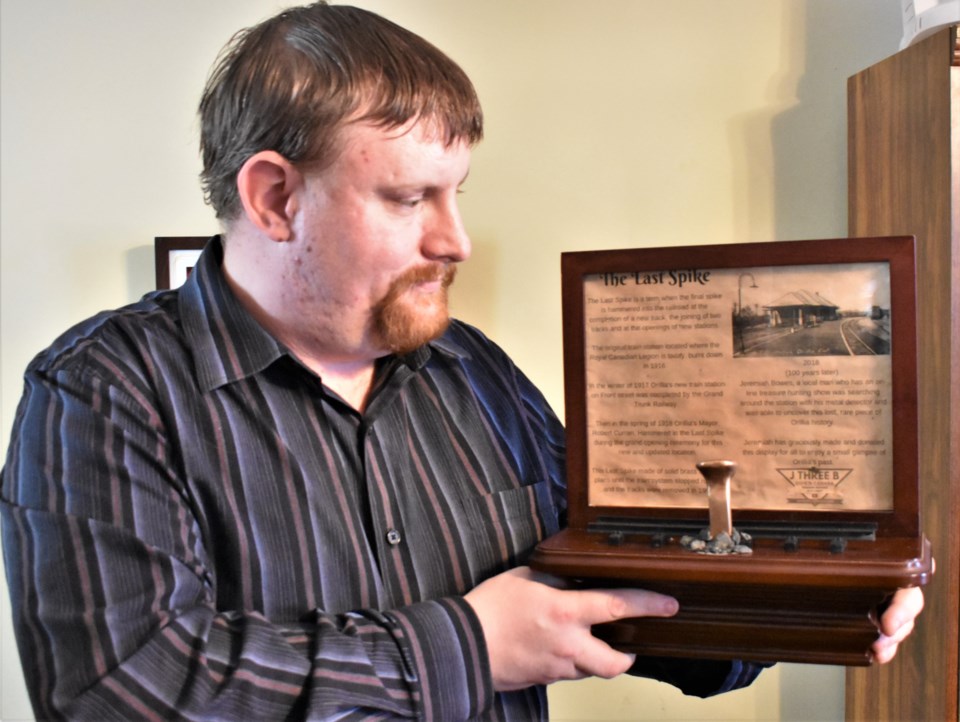A local treasure hunter has struck gold. Or, rather, brass.
Jeremiah Bowes, a self-professed history buff who can often be seen, armed with his ever-present metal detector looking to unearth relics from the past, discovered an important part of Orillia’s past recently.
While scanning the grounds around the old train station on Front Street, his metal detector jangled with its telltale sound. That was not a big surprise; he had already come across several items of no significance.
When he dug into the ground, and found a blackened piece of metal, he assumed it was just another soot-covered, rusty railroad spike.
But then, he started rubbing off the black charcoal; it was like rubbing a genie’s lamp. Suddenly, the dirt gave way to something quite beautiful.
“I could tell it was not the same size as the other spikes I had found and this one wasn’t all beat up and rusty like the others,” said Bowes. “This one was smooth and thinner than a traditional spike. And it wasn’t made of iron … it was solid brass.”
The find kindled Bowes’ love of history and sparked a trip to the library that led to a search of local newspaper archives and long chats with helpful local history buffs at the library.
Eventually, Bowes discovered that in 1918, Orillia Mayor Robert Curran drove in a ceremonial brass spike, ‘the last spike’, to signal the conclusion of the construction of the new train station on the site; it replaced the fire-ravaged station that had been located at the present-day site of the legion.
“I had never heard of a ‘last spike’ ceremony and didn’t know anything about it,” said Bowes. “We found a reference in the Barrie Examiner encouraging people to go to the grand opening of the Orillia Train Station. That’s when the mayor drove in the last spike.”
Bowes suspects that when the tracks were removed in 1998, the brass spike, lighter than the rest, was likely catapulted into the weeds and lost to time.
The local treasure hunter says the brass in the spike is likely worth, at most, $5. But to him it’s a priceless piece of Orillia’s history.
“It’s definitely the find of a lifetime,” he said. “It’s priceless to me.”
He has made a hand-crafted cabinet for the last spike and curated it with a story about its provenance. Officials at the Orillia Museum of Art and History will display it in their lobby in the new year.
“I have agreed to loan it to them,” said Bowes. “I would love for it to travel to different places. It would be great to display it inside the train station – I’d love for it to go there for a while.”
The “once-in-a-lifetime” find has Bowes wishing it wasn’t winter; he’d love to be out hunting.
“It’s an amazing hobby,” said Bowes, who is attempting to turn that passion into a career. “You would be amazed at the stuff that lies underneath your feet.”
Bowes home is filled with relics he has dug up. He has an old bottle collection and dozens of smaller collections of belt buckles, bullets, marbles, keys and other historical items.
“I’m not looking for old coins, like some. I go for the relics,” he said, noting he was stoked when he found a belt buckle from the 1700s or an old military pocket knife. “I love the history you can find and it’s amazing to see how things can last this long in the dirt. It’s breathtaking.”
Bowes shares his passion through the Orillia Metal Detecting Club, which he runs. It meets occasionally at the Orillia Public Library.
You can find more information about the club on his Facebook Page or discover more about treasure hunting on his YouTube page. http://www.youtube.com/jthreeb
